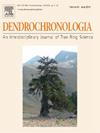不同的气候信号嵌入在沿海拔梯度的红木蓝强度:来自美国内华达州大盆地的多物种案例研究
IF 2.7
3区 农林科学
Q1 FORESTRY
引用次数: 0
摘要
随着蓝强度(BI)方法在全球范围内被越来越多地用于生成温度敏感的树木年轮记录,在BI参数中,站点内海拔变化对气候-生长关系的影响在很大程度上仍未得到解决。在这里,我们沿着海拔梯度对两种山地针叶树种Abies concolor var. concolor (Gordon &;Glend)。采用。Ex Hilderb和Picea engelmannii Ex Engelm。生长在干旱的美国西南部。在这一研究中,我们发现最高海拔样地的LWBI年代学与春夏气温(4 - 8月,r >; 0.46)之间存在显著正相关(p <; 0.05)。此外,在不同的季节窗内,彩蚜的正温度响应通常比恩格尔曼氏假单胞菌更强,时间上也更稳定。在比较不同物种和海拔对气候响应的差异时,我们发现白桦LWBI的温度响应之间存在明显的临床关系,其中正温度信号的强度和时间稳定性都随着海拔的升高而增加。同时,中高海拔的恩格尔曼草表现出最高的气候敏感性。因此,我们的发现有助于更全面地了解海拔如何影响LWBI参数中嵌入的气候信息的类型和强度,这些信息来自生长在其历史范围边缘附近的干旱山地针叶树。本文章由计算机程序翻译,如有差异,请以英文原文为准。
Varying climate signals embedded in latewood blue intensity along an elevational gradient: A multi-species case study from the Great Basin, Nevada, USA
As blue intensity (BI) methods are increasingly employed to generate temperature-sensitive tree-ring records around the globe, the influence of intra-site variation in elevation on climate-growth relationships for BI parameters remains largely unresolved. Here, we develop six latewood blue intensity (LWBI) chronologies along an elevational gradient for two montane conifer species, Abies concolor var. concolor (Gordon & Glend.) Lindl. Ex Hilderb and Picea engelmannii Parry ex Engelm., growing in the arid southwestern United States. In this first documented study to examine the climate response of LWBI from A. concolor, we find positive, significant (p < 0.05) correlations between the LWBI chronology from the highest elevation plot and spring–summer temperatures (April–August, r > 0.46). Moreover, the positive temperature response of A. concolor is generally stronger and more temporally stable than for P. engelmannii across varying seasonal windows. In comparing the differences in climate response across species and elevation, we document distinct clinal relationships between the temperature response of LWBI for A. concolor, where both the strength and temporal stability of the positive temperature signal increases with elevation. Meanwhile, the mid-elevation P. engelmannii demonstrate the highest climate sensitivity. As such, our findings contribute to a more comprehensive understanding of how elevation influences the type and strength of the climatic information embedded within the LWBI parameter from arid, montane conifers growing near their historical range margins.
求助全文
通过发布文献求助,成功后即可免费获取论文全文。
去求助
来源期刊

Dendrochronologia
FORESTRY-GEOGRAPHY, PHYSICAL
CiteScore
5.50
自引率
13.30%
发文量
82
审稿时长
22.8 weeks
期刊介绍:
Dendrochronologia is a peer-reviewed international scholarly journal that presents high-quality research related to growth rings of woody plants, i.e., trees and shrubs, and the application of tree-ring studies.
The areas covered by the journal include, but are not limited to:
Archaeology
Botany
Climatology
Ecology
Forestry
Geology
Hydrology
Original research articles, reviews, communications, technical notes and personal notes are considered for publication.
 求助内容:
求助内容: 应助结果提醒方式:
应助结果提醒方式:


